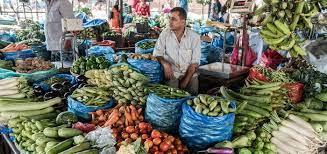
https://www.fao.org/newsroom/detail/as-the-pace-of-urbanization-quickens...
Bangkok – Asia’s cities are growing at such a fast pace that nearly 55 percent of the region’s enormous population is expected to reside in urban areas by 2030, and that will have equally enormous consequences for urban food security and nutrition, according to the main findings of a new report by four United Nations agencies.
But the threat is not only a future concern, the results are being felt now, according to the ‘Asia and the Pacific Regional Overview of Food Security and Nutrition 2022 – Urban Food Systems and Nutrition’. Published jointly each year, the “SOFI” report is prepared by the Food and Agriculture Organization of the United Nations (FAO), the United Nations Children’s Fund (UNICEF), the World Food Programme (WFP) and the World Health Organization (WHO).
The convergence of an increase in low-income settlements, the rising costs of food and the need for developing an urban food agenda that takes into account infrastructure, transport, clean water and waste management are posing new challenges to planners and national policymakers across the Asia-Pacific region.
This report’s highlights, revealed today, capture the challenges and system-level determinants of unhealthy diets in urban areas, both with regard to undernutrition and overweight and obesity. They profile various urban environments, interventions, experiences and the opportunities to innovate at multiple levels to transform urban areas into sustainable cities. Increasingly, food security and nutrition in the urban context will determine progress, or lack thereof, towards achieving the Sustainable Development Goal to eliminate hunger (SDG2) and the World Health Assembly (WHA) 2030 targets on food security and nutrition.
Asia-Pacific already backsliding in food security targets
This is the fifth annual Asia-Pacific regional SOFI report. In recent years, previous editions reported that progress in the fight against hunger and all forms of malnutrition was stalling, then regressing and more recently pushing us further off track from achieving the SDGs.
This reverse was evident even before the COVID-19 pandemic took hold in 2020. But as the pandemic continued, albeit in a milder form in most parts of the region by 2022, the 5F crisis emerged (lack of food, feed, fuel, fertilizer and finance), as did the conflict between Russia and Ukraine, two of the world’s major agricultural producers. The convergence of these and other issues during the past year resulted in unprecedented food and energy price rises that have hit households and livelihoods hard and pushed additional millions more into hunger and poverty.
In March 2022, the FAO Food Price Index (FPI) capped a steady rise through the previous two years of the COVID-19 pandemic and rose to the highest level since its inception. Since then the FPI has fallen somewhat but remains significantly higher by 28 percent over 2020. High agricultural input prices, concerns about the weather and climate, and increased market uncertainties stemming from the continuing war in Ukraine, are contributing to a tightening of food markets. Food import bills are likely to touch a new record of USD 1.94 trillion this year, according to FAO’s latest Food Outlook published in November. Without doubt, the convergence of these negative factors will exacerbate hunger and poverty in Asia and the Pacific, the world’s most populous region.
Urgent action needed to combat stunting, overweight and obesity
The report’s figures paint a grim picture, one that requires a call for urgent action. In 2021, 396 million people in the region were undernourished and an estimated 1.05 billion people suffered from moderate or severe food insecurity. Nearly 75 million children below the age of five in Asia and the Pacific are stunted, amounting to half of the world’s total. Ten percent are affected by wasting, while poor diet quality also drives overall increases in child overweight and obesity.
Among older children and adults, obesity continues to rise in every country of this region. The Pacific Island Countries have the highest prevalence of overweight and obesity in the world. Obesity is a risk factor for many non-communicable chronic diseases (NCDs) and it has a major impact on national economies by reducing productivity and life expectancy and increasing disability and health care costs. No country in Asia and the Pacific is on track to meet the WHA target of no increase in adult obesity.
Making the situation worse is the cost of attaining a healthy diet. In this region, a healthy diet is unaffordable in most countries for nearly two billion inhabitants (1.9 billion persons, which is 44.5 percent of the region’s population). The combined impacts of the pandemic and ongoing inflation have pushed up the average cost of a healthy diet to nearly USD 4 per day (USD 3.98 per person, per day), the report finds.
A call to action and action underway
During the year, as the 5F crisis intensified, our four UN agencies took the initiative to join hands at regional and country level to deliver coordinated technical support to countries and actions. We called upon all country representatives and directors to synergize their efforts to address the short-term effects as well as the medium- to long-term impacts, the crisis will have on economies, households and individuals, particularly women and children, in the region.
At the same time, the key principals of the report pointed out that the crisis is an opportunity to build on the momentum of the UN Food Systems Summit of 2021. Together, the agencies are intensifying efforts with member countries to reshape and reimagine food systems across the region to make them more efficient, inclusive, resilient and sustainable, leaving no one behind. However, governments, civil society, the private sector, funding and development agencies will need to continue to demonstrate leadership and partnership to bring about transformative change in agrifood systems and show improved figures in this flagship report in the years to come.
The main findings of the report were launched today at an event in Bangkok. The full report will be available online soon.










Add new comment